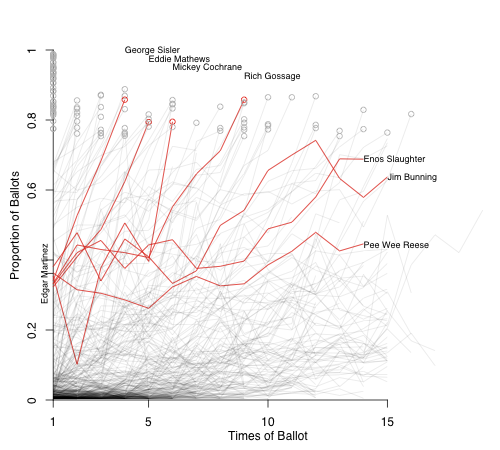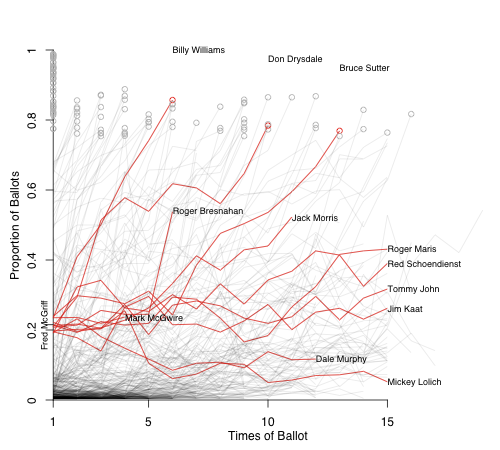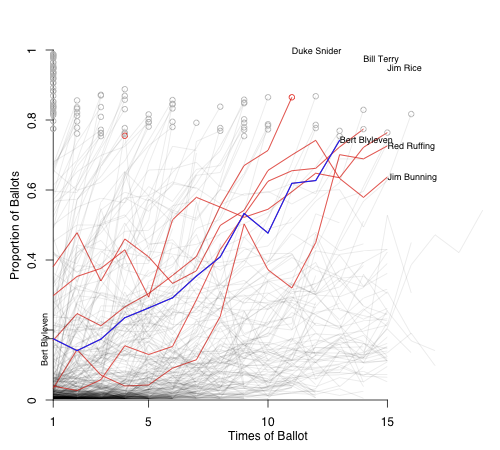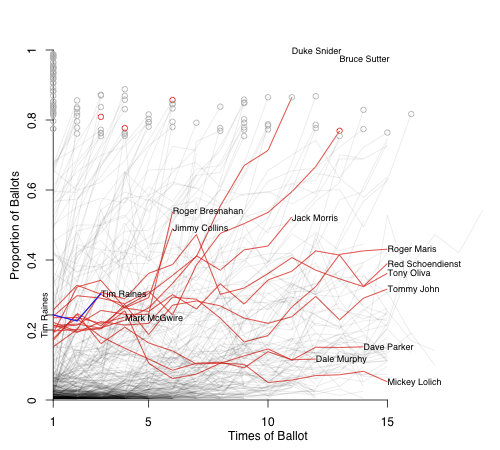
| F/X Visualizations | January 08, 2010 |
First off congratulations to Andre Dawson on his election to the Hall of Fame.
In this post I want to look at the some of the other players on the ballot and see what we can say about their possible vote trajectory based on looking at historic comparables. But just to be clear from the outset, these are not predictions, as the small sizes are quite small.
In these plots I show how the vote share of each player changed over his subsequent ballots. Along the x-axis is the number of times on the BBWAA ballot, and on the y-axis the proportion of votes he got on that ballot. Circles indicate when a player reached the 75% level. I do not indicate players elected by any manner other than the BBWAA. For each graph I highlight a group of comparable players in red.
First off let's look at Roberto Alomar. He got 73.7%; that is the closest a first-year player has come to 75%. So I compared him to all players who received less than 75% but greater than 60%.

These players were all elected relatively quickly, with most elected the next year. Phil Niekro lost some support in his second year and had to wait the longest, five years, before induction.
Barry Larkin was next among first-year players. He got 51.6% and I looked at players who received within 5% points of that total.

These players were, also, all eventually inducted. Cy Young, the only player in this group to get in on the second try, was not in the Hall's first class, but his vote total shot up the next year and he was elected. I don't think this is the best comparison for Larkin; he will probably have to wait more than one more year. In this group Tony Perez took the longest, as his votes meandered upward for a number of years before being elected in 2000 on his 9th ballot. But history looks good for Larkin.
Next among first-year players is Edgar Martinez, who had 36.2%. There are a lot more players in this range so I just looked at those within 2.5% points.

Four of these players shot up quickly and were elected before their tenth time on the ballot. The other three never reached 75% -- although Jim Bunning came painfully close on his 12th time on the ballot -- but all were, ultimately, inducted by the Veterans Committee.
The only other first-year player to reach 5% was Fred McGriff. I highlight others withing 2.5% points of his 21.5%.

This presents a more muddled picture. Three guys reached 75%, in as fast as six years or as long as 13 ballots. Roger Bresnahan was elected by the Old Timers Committee, a precursor to the Veterans Committee. Red Schoendienst was elected by the Veterans Committee. Three of his comparables are still on the ballot and the last four didn't make it in.
Finally I am going to turn my attention to the two saber-darlings on the ballot: Tim Raines and Bert Blyleven. For these two we have more data than just their first year vote total so I am going to construct their comparables differently.
Blyleven, as Rich covered yesterday, came very close, falling just five votes shy. Here I highlight all other players who received over 70% but less than 75% on a ballot late in the process (tenth ballot or after).

Going by initial vote starting from the highest: Bunning's first total was just under 40% and he -- as noted above -- reached 74.2%, but that was his high-water mark and was ultimately inducted by the VC. Next is Jim Rice who got 74.2% in his 14th year on the ballot and was elected on his 15th ballot last year. Duke Snider started with a total very close to Blyleven's and road a steady growth to the fastest induction among this group. Bill Terry started at just 4% -- this was before players who did not reach 5% were dropped -- and his vote share increased steadily and he was elected in his 14th year. Finally Red Ruffing, who also started below 5%, increased steadily and in his 14th year, 1967, received 72.6%. At the time if no player was elected the BBWAA would hold a runoff and the top vote getter would be inducted. Ruffing was elected in the 1967 runoff.
Tim Raines has been on the ballot for three years with the following totals: 24.3%, 22.6% and 30.4%. For his group I chose players who got between 15 and 35% in each of their first three years.

This is a mixed bag. Jimmy Collins and Bresnahan were inducted by the Old Timers Committee, and Schoendienst by the VC. Two guys reached 75%, four are still on the ballot and the other four didn't make it. We will see how it goes for Raines.
Again with the small sample size these are in no way predictions, but an attempt to put these players's vote totals in some historical perspective.
Comments
Dave
Great job! It is helpful to see this all laid out.
Any thoughts on Billy Williams and how he progressed so quickly? He had 5 straight years with a double digit increase and got way above the necessary 75% when he did get elected. I guess in 5 years 200 guys or more (and half or more of all the voters) changed their mind about him. Here is how his vote progressed:
1982 BBWAA (23.4%)
1983 BBWAA (40.9%)
1984 BBWAA (50.1%)
1985 BBWAA (63.8%)
1986 BBWAA (74.1%)
1987 BBWAA (85.7%)
Cy
Posted by: Cyril Morong at January 8, 2010 9:08 AM
I really liked the graphical representation. Which program did you use to create those graphs?
Posted by: Andrew at January 8, 2010 9:21 AM
Cy,
I am not a big baseball historian so I cannot comment, other than to say it is a dramatic increase in votes. Maybe others can share their thoughts.
Andrew,
The graphs are made in R.
Posted by: Dave Allen at January 8, 2010 9:58 AM
Great idea and presentation. I agree with Cy. I wonder what's up with Billy Williams and Red Ruffing.
Posted by: Jeremy Greenhouse at January 8, 2010 10:27 AM
Loved this, thanks.
Posted by: jinaz at January 8, 2010 1:59 PM
Interesting way of breaking down the chances for each player's projected success in making it into the HOF. It would be interesting to see how this process would play out if voters didn't have the luxury of waiting fifteen years before they really had to commit themselves. For example, would Jim Rice have been inducted if the process lasted only five years, or would he have been snubbed?
Posted by: Bill Miller at January 8, 2010 3:42 PM
I have never seen anything like this. It's a fantastic graphical representation that before now I would judge on intuition.
Thanks for putting this together.
Posted by: JOCKpost at January 8, 2010 7:35 PM
I think it would be interesting to show a guy like Luis Aparicio his was a pretty interesting path. Were there others like him?
Posted by: jim at January 14, 2010 8:08 AM